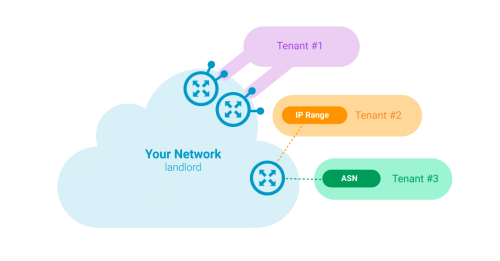Overview
The Japan Network Access Point (JPNAP) is the largest internet exchange (IX) in Asia. It delivers reliable, ultra-high-speed connectivity to and between ISPs, cable TV services, cloud service providers, CDNs and large enterprises. When JPNAP’s network managers realized that their in-house network monitoring tools were limited in visibility and increasing in OPEX, they adopted the Kentik platform and the built-in My Kentik Portal for network observability. Kentik helps JPNAP and its customers understand complex traffic patterns to keep networks and services running smoothly.
Situation
JPNAP is operated by the Internet Multifeed Co. (IMF), an NTT-affiliate company. The internet exchange gives reliable Layer 2 connectivity to more than 200 service providers and enterprise customers from connection points in four cities: Tokyo, Osaka, Fukuoka and Sendai.
IX providers like JPNAP play a critical role in today’s digital economy, making sure that service providers and enterprises have sufficient bandwidth on demand. It’s the JPNAP network operations team that is responsible for ensuring around-the-clock reliability, availability and performance.
“Our number-one priority is to ensure that our customers receive the highest levels of network performance and reliability because they, in turn, have customers who rely on them,” says Shinji Kawaguchi, a distinguished engineer of JPNAP. To do this, JPNAP requires network management systems that can closely monitor all aspects of network traffic and alert managers to any anomalies that might lead to potential service disruptions.
Kawaguchi is particularly focused on visualization tools that make it easy to understand the state of network operations — both for the JPNAP team and its customers.
“Since 2005, JPNAP has provided a network traffic engineering service called PeerWatcher for our customers. PeerWatcher gives a significant boost to our customers’ ability to monitor and optimize their own networks by visualizing peer-to-peer traffic,” Kawaguchi says.
However, the PeerWatcher service was using flow-monitoring and visualization tools developed in-house by JPNAP. After more than a decade of use, the system was becoming outdated and operating expenses were increasing, Kawaguchi says. In addition, rapid customer growth and a corresponding spike in traffic volume strained the system’s ability to scale. This limited the ability to extract real-time traffic information on network performance and reliability.
Solution
Kawaguchi and colleagues started looking at options for improving their network management systems. One of the first options they considered was the Kentik platform. “My boss first learned about Kentik at the Peering Asia 1.0 in 2017, so I started looking into it. We eventually did a proof-of-concept trial, which proved that it met all of our requirements,” he recalls.
Specifically and very quickly, the Kentik platform proved it could deeply enhance the level of detailed network insights that could be shared among all team members within JPNAP. The team also needed the ability to easily share network performance information with customers. My Kentik Portal (MKP), a built-in feature of the Kentik platform, proved it could address that need. MKP enables customized, self-service network observability for downstream customers of communications service providers and large enterprises.
“My Kentik Portal is a huge plus for us and our customers,” Kawaguchi says. “It allows us to seamlessly share all the information and analysis generated by the Kentik platform with our customers in a way that is customized to their particular needs. It also reduces our operating costs because we no longer need to develop and maintain our own tools to provide this information. It’s a win-win for both us and our customers.”
JPNAP was the first IX provider to offer MKP to its own customers. Over the years, the team at JPNAP has continued to collaborate with the Kentik team on new features to implement within MKP. And as a result, JPNAP’s IX customers have granular details into their own network traffic, too.
With his emphasis on visualization tools, Kawaguchi says he’s pleased with Kentik’s ease of use. “Not only is Kentik rich in information, but it also presents that data in ways that are easy to understand. At a glance, we can see the status of any connection or be alerted to any issue that needs attention.”
After years spent developing and maintaining in-house network visualization tools, Kawaguchi relishes the regular updates and added features from Kentik. “The speed at which Kentik has responded to our requests has been impressive,” he says. “Kentik has greatly improved our ability to analyze traffic and has given us significant competitive advantages.”
Results
JPNAP applies the Kentik Network Observability Platform to several use cases:
Proactive network performance management
At a glance, network managers see the status of all network connections, receiving proactive alerts of any anomalies that could indicate an issue needing attention. Tests can be run on a regular or as-needed basis to ensure that availability and performance meet JPNAP’s standards.
“Kentik has improved the traffic analysis capabilities of our operations teams,” Kawaguchi says. “We have more opportunities to analyze traffic in detail and see the impact of any problems.”
Fast troubleshooting
When a network problem occurs, time-to-resolution is critical. Kentik delivers comprehensive, highly granular data that network managers can use to quickly identify the precise location of an issue and then drill down to learn the details.
Outstanding customer experience
By using My Kentik Portal, JPNAP gives network observability to its customers with an unprecedented level of detail about their own networks. This allows their customers to also answer questions about their own networks, such as: How much traffic is coming in or from my network? And which networks are our traffic going to, or coming from?
“We are able to quickly provide customized dashboards based on individual customers’ requests,” Kawaguchi notes. “We have received many comments from customers about how valuable the information is and how easy Kentik is to use.”
Strengthened security
Kentik adds valuable detail to tools and procedures that the JPNAP team uses to guard against DDoS attacks and other external security threats. Kentik’s proactive, AI-powered alerts highlight anomalous behavior or unusual traffic patterns that can be a harbinger of a security threat. And Kentik data — both real-time and historic — provides valuable assistance in pinpointing the source(s) and path(s) of attackers.
Key takeaways
With Kentik, JPNAP’s network managers have unprecedented levels of highly detailed, real-time insights into all aspects of network operations. This leads to enhanced service to customers and lower OPEX. At the same time, JPNAP customers and resellers who use My Kentik Portal gain a deeper understanding of their own networks.
“We appreciate the partnership we have with the Kentik team and their innovation in implementing many of the My Kentik Portal features we’ve suggested to best serve our IX customers’ network traffic needs,” Kawaguchi says.
“I’m a big fan of Kentik,” he adds.

Category
- Internet exchange
Challenge
- Legacy traffic-monitoring tools were difficult and expensive to maintain
Solution
- The Kentik Network Observability Platform provides a comprehensive, real-time view of performance throughout all JPNAP networks
- The My Kentik Portal gives JPNAP customers highly detailed insights into their own operations
Results
- Proactive network performance management
- Fast troubleshooting
- Outstanding customer experience
- Strengthened security
Solutions
- Reduce Cloud Spend
- Migrate To and From Any Cloud
- Improve Cloud Performance
- Optimize Enterprise WAN
- Network Performance Monitoring
- Deliver Exceptional Digital Experiences
- Detect and Mitigate DDoS
- Harden Zero-Trust Cloud Network Policy
- Investigate Security Incidents
- Visualize All Cloud and Network Traffic
- Troubleshoot Any Network
- Understand Internet Performance
- Consolidate Legacy Tools
- Optimize Peering and Transit
- Plan Network Capacity


